The NVIDIA GeForce GTX 780 Ti Review
by Ryan Smith on November 7, 2013 9:01 AM ESTCompute
Jumping into compute, we’re entering the one area where GTX 780 Ti’s rule won’t be nearly as absolute. Among NVIDIA cards its single precision performance will be unchallenged, but the artificial double precision performance limitation as compared to the compute-focused GTX Titan means that GTX 780 Ti will still lose to GTX Titan whenever double precision comes into play. Alternatively, GTX 780 Ti still has to deal with the fact that AMD’s cards have shown themselves to be far more competitive in our selection of compute benchmarks.
As always we'll start with our DirectCompute game example, Civilization V, which uses DirectCompute to decompress textures on the fly. Civ V includes a sub-benchmark that exclusively tests the speed of their texture decompression algorithm by repeatedly decompressing the textures required for one of the game’s leader scenes. While DirectCompute is used in many games, this is one of the only games with a benchmark that can isolate the use of DirectCompute and its resulting performance.
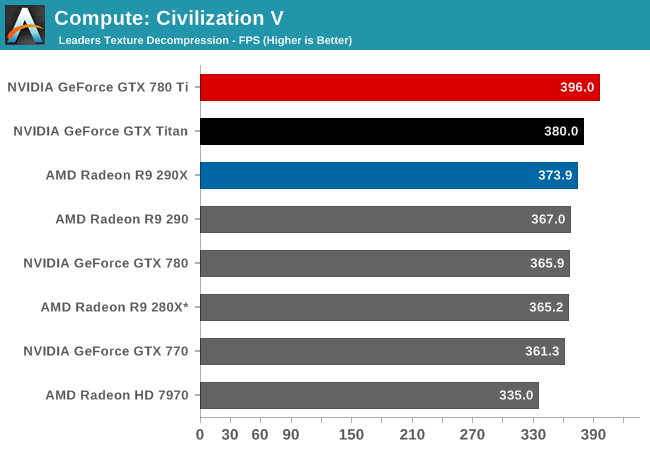
Even though we’re largely CPU bound by this point, GTX 780 Ti manages to get a bit more out of Civilization V’s texture decode routine, pushing it to the top of the charts and ahead of both GTX Titan and 290X.
Our next benchmark is LuxMark2.0, the official benchmark of SmallLuxGPU 2.0. SmallLuxGPU is an OpenCL accelerated ray tracer that is part of the larger LuxRender suite. Ray tracing has become a stronghold for GPUs in recent years as ray tracing maps well to GPU pipelines, allowing artists to render scenes much more quickly than with CPUs alone.
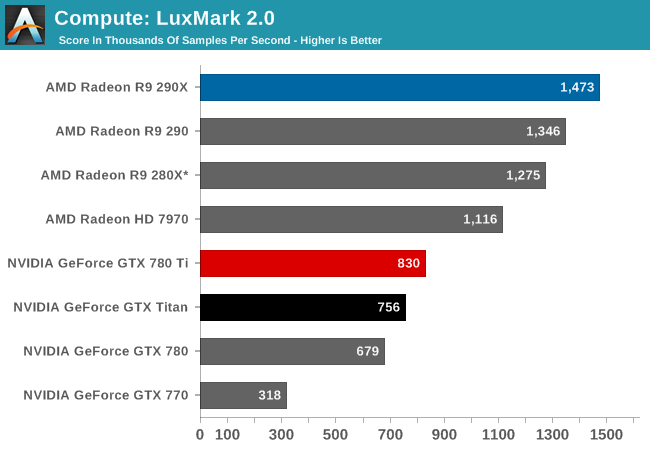
With LuxMark NVIDIA’s ray tracing performance sees further improvements due to the additional compute resources at hand. But NVIDIA still doesn’t fare well here, with the GTX 780 Ti falling behind all of our AMD cards in this test.
Our 3rd compute benchmark is Sony Vegas Pro 12, an OpenGL and OpenCL video editing and authoring package. Vegas can use GPUs in a few different ways, the primary uses being to accelerate the video effects and compositing process itself, and in the video encoding step. With video encoding being increasingly offloaded to dedicated DSPs these days we’re focusing on the editing and compositing process, rendering to a low CPU overhead format (XDCAM EX). This specific test comes from Sony, and measures how long it takes to render a video.

Like LuxMark, GTX 780 Ti once again improves on its predecessors. But it’s not enough to make up for AMD’s innate performance advantage in this benchmark, leading to GTX 780 Ti trailing all of the AMD cards.
Our 4th benchmark set comes from CLBenchmark 1.1. CLBenchmark contains a number of subtests; we’re focusing on the most practical of them, the computer vision test and the fluid simulation test. The former being a useful proxy for computer imaging tasks where systems are required to parse images and identify features (e.g. humans), while fluid simulations are common in professional graphics work and games alike.
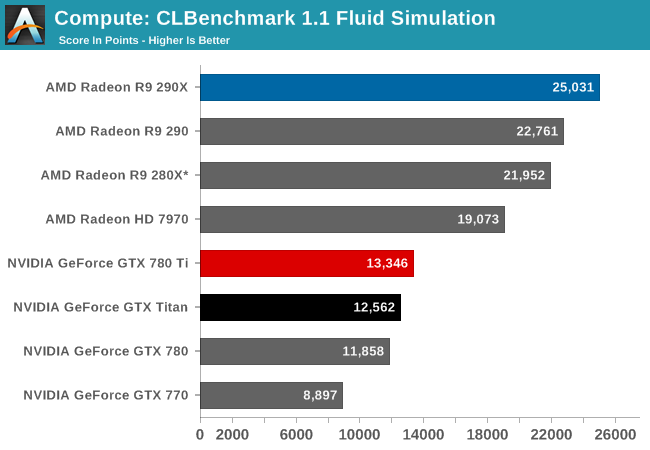
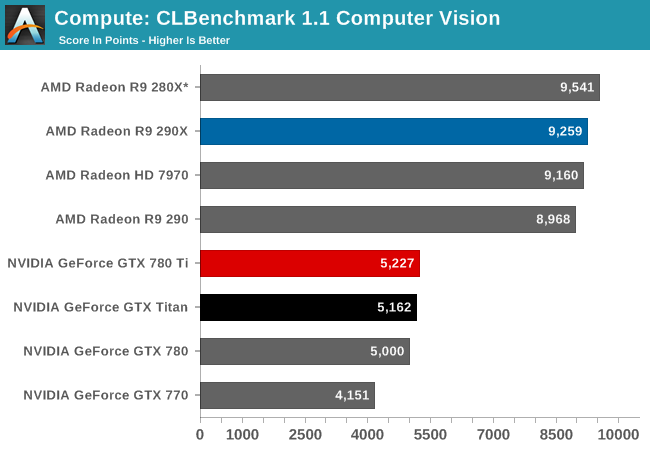
CLBenchmark continues to be the same story. GTX 780 Ti improves on NVIDIA’s performance to become their fastest single precision card, but it still falls short of every AMD card in these tests.
Moving on, our 5th compute benchmark is FAHBench, the official Folding @ Home benchmark. Folding @ Home is the popular Stanford-backed research and distributed computing initiative that has work distributed to millions of volunteer computers over the internet, each of which is responsible for a tiny slice of a protein folding simulation. FAHBench can test both single precision and double precision floating point performance, with single precision being the most useful metric for most consumer cards due to their low double precision performance. Each precision has two modes, explicit and implicit, the difference being whether water atoms are included in the simulation, which adds quite a bit of work and overhead. This is another OpenCL test, as Folding @ Home has moved exclusively to OpenCL this year with FAHCore 17.

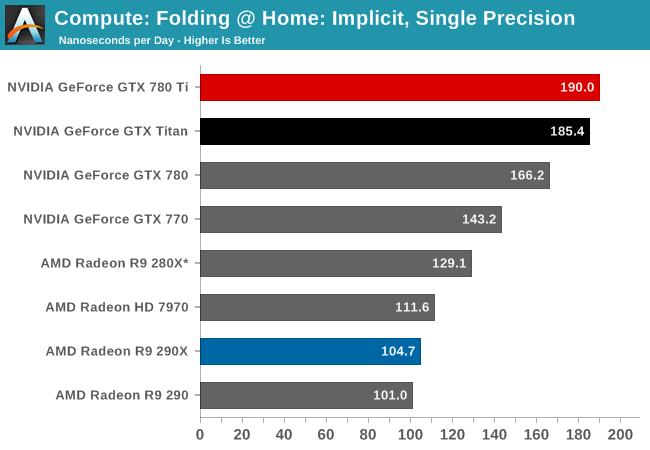
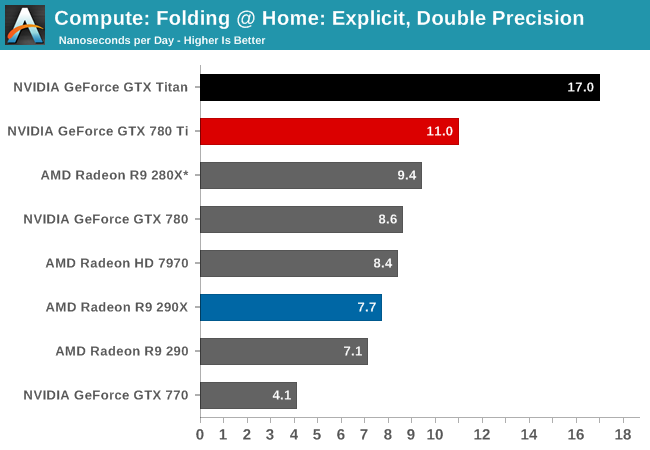
Finally with Folding@Home we see the GTX 780 Ti once again take the top spot. In the single precision tests the GTX 780 further extends NVIDIA’s lead, beating GTX Titan by anywhere between a few percent to over ten percent depending on which specific test we’re looking at. However even with GTX 780 Ti’s general performance increase, in the double precision test it won’t overcome the innate double precision performance deficit it faces versus GTX Titan. When it comes to double precision compute, Titan remains king.
Wrapping things up, our final compute benchmark is an in-house project developed by our very own Dr. Ian Cutress. SystemCompute is our first C++ AMP benchmark, utilizing Microsoft’s simple C++ extensions to allow the easy use of GPU computing in C++ programs. SystemCompute in turn is a collection of benchmarks for several different fundamental compute algorithms, as described in this previous article, with the final score represented in points. DirectCompute is the compute backend for C++ AMP on Windows, so this forms our other DirectCompute test.
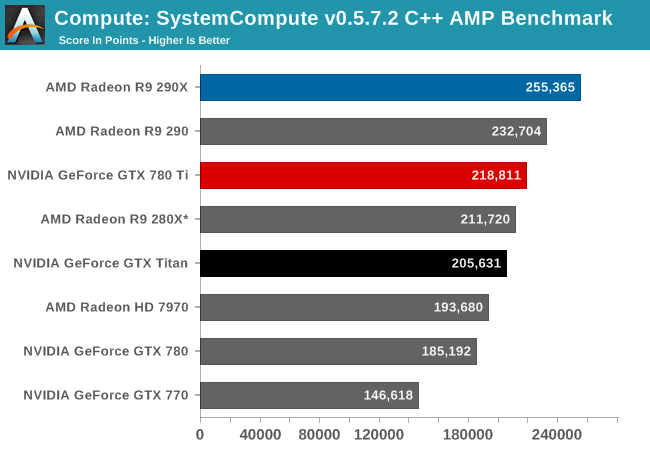
Last, in our C++ AMP benchmark we see the GTX 780 Ti take the top spot for an NVIDIA card, but like so many of our earlier compute tests it will come up short versus AMD’s best cards. This isn’t quite as lopsided as some of our other tests, however GTX 780 Ti is stuck competing with the 280X while the 290 and 290X easily outperform NVIDIA’s new flagship.










302 Comments
View All Comments
dwade123 - Friday, November 8, 2013 - link
Only morons will buy current gen cards on steroids.MLSCrow - Friday, November 8, 2013 - link
Never in all my life of being a supporter of Anandtech have I been so disgusted by the overly obvious bias toward NVidia. The GTX780Ti is a JOKE at $700.just4U - Friday, November 8, 2013 - link
As much as I hate to admit this.. I "DO" like to see AMD succeed.. that being said I don't favor them over NVidia.. and Anandtech's reviews are fair/balanced. I think all reviewers have a preference.. and sometimes that shows in their reviews.. but it's really hard to pinpoint what Ryan's are. The guy can't win with NVidia or AMD die-hard fans. He gets criticized for being a fanboy of both.Ranger101 - Friday, November 8, 2013 - link
I hear you, I have followed Anandtech for decades but this kind of rubbish is definitely making me think about looking at other tech sites for a balanced perspective...shame on you Anandtech.Ranger101 - Friday, November 8, 2013 - link
At 4K resolutions the R290X beats 780Ti every time. How is it possible to conclude that 780Ti is 11% faster than R290X when the former card is consistently beaten at 4K resolutions which is the ultimate test of a cards speed? How much is Nvidia paying you to write this junk?polaco - Friday, November 8, 2013 - link
Indeed that performance difference is very tricky. In most cases they are head to head. And for 150 bucks less it's a no brainer 290X is the winner. However 290 seems so sweet at that price that puts me into real doubt if 290X is worthy. Radeon 290 looks lovely.Yojimbo - Friday, November 8, 2013 - link
He explains his reasoning quite clearly, and I think the reasoning is sound. 4K resolution is still out of the reach of a single-GPU card, because in order to achieve it, one must either accept painfully low frame rates, or run on extremely low quality settings, no matter what single-GPU card is chosen. Neither of these options makes much sense, but if you wish to take advantage of them, the data is there and you are free to ignore his analysis and pursue your own; Buy a 290X and a 4K monitor. But in terms of "victory" for AMD, it seems to me that running 4K somewhat faster, but still not fast enough to be usable, is meaningless.Jaboobins - Friday, November 8, 2013 - link
The memory frequency for the GTX 770 is wrong. It needs to be 7Ghz not 6Ghz.But damn is that 780 GTX ti is fast!
wwwcd - Friday, November 8, 2013 - link
I got a rumour for r9 290x with 8GB 7+ GHz GDDR5 VRAM. WoW!, if that will be made real the card be have twice speed bandwidth than normal refferent r9 290x. GTX 780 will be downed to ground. Hardly ;)slickr - Friday, November 8, 2013 - link
At $700 its a bit too expensive, especially when you consider it averages only about 5% increase in performance over the Titan and about 9% increase in performance over the 780, which when translated to raw numbers, its only 3-4 frames.I mean whether a game runs at 50 or 54 frames is of no significance, especially if you have to pay $200 more for it.
I think the 780 Ti is good in its own right, but its just not good enough when compared to the competition and when you consider the price.
The 290x is $550 and in some cases is still faster than the 780 Ti, all this with a terribly designed cooler, which will be replaced by custom coolers by 3rd party in the next week or two.
So at this point we are looking at a $550 290x with a custom cooler that will be able to run even faster with a better cooler, which means beating the new 780 Ti in many benchmarks and drawing in others all at $150 less.
So yeah, Nvidia may have released a slightly faster card than the 780 and Titan, but considering the price and what the competition is offering, it isn't very appealing.
If it launched at $600 it may have been reasonable and you have a 10% slower 780 at $500 and in between the 290x at $550 and it could make sense to go for the 780Ti, but right now I don't really see the appeal.